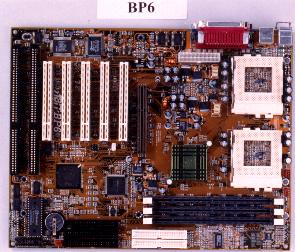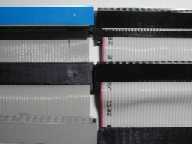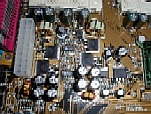Asus P2B-DS
 Abit BP6
Abit BP6
EPoX KP6-BS
Shuttle HOT-649A
Tyan S1832DL
Tech Talk
Dual Celeron
UDMA66 vs SCSI
Intel CPU Fan Hack
LVS SCSI
CPU Core Temp.
 |
|||||||||||||||||||||||||||||||||||||||||||||||||||
ABIT BP6Low cost, feature packed and design with overclock in mind.by Derek Kwan
 "Nothing is impossible!" We are so glad to
receive ABIT's BP6 for our testing, thanks Nic. ABIT's BP6 is the FISRT and ONLY Dual Socket 370 Motherboard you
can buy. If you want a low cost solution for dual processors machine, look no futher, buy yourself a
BP6, pop in 2 PPGA Celeron Processors and off you go. When you take a closer look at ABIT's BP6, it is more than
a just multi-processor capable, it is a feature packed high performance motherboard. "Nothing is impossible!" We are so glad to
receive ABIT's BP6 for our testing, thanks Nic. ABIT's BP6 is the FISRT and ONLY Dual Socket 370 Motherboard you
can buy. If you want a low cost solution for dual processors machine, look no futher, buy yourself a
BP6, pop in 2 PPGA Celeron Processors and off you go. When you take a closer look at ABIT's BP6, it is more than
a just multi-processor capable, it is a feature packed high performance motherboard.
While Intel's 440BX chipset, it is not designed for UDMA/66 standard. UDMA/33 which is what the BX chipset
can do the best. It is only cabable of running a maximum of 33MB/s transfer rate per IDE channel. But with
No, this is not a iMac marketing scheme. Overclock is for sure today's hottest topic for the power hungry users. BP6 once again clearly demonstrate their commitment to customer's need. This is (to our knowledge) the only motherboard can give you substantial overclock features. If you are already a owner of BX6 (or BX6 Ver 2) or BH6 you already know how handy is their SoftMenu II jumperless CPU Frequency settings. ABIT's engineer has once again making all overclocker's dream come true. On BP6, you can now go with 1MHz increment on FSB setting in between 82MHz to 100MHz range. Why overclockers need 1MHz increments, espically in this range? For most Celeron Processors it can run at 83MHz FSB without problems but it will fail at 100MHz FSB under normal conditions. So it means the Celeron Processor fails somewhere in between. From 66MHz to 75Mhz is about 13% incerment, and 75MHz to 83MHz is about 11% incerment, but from 83MHz to 100MHz is a whopping 20% jump. So you can see Celeron overclockers would like to have a FSB somewhere in between to get the extra juice from their CPU. Here is a list of frequencies you can set (from SoftMenu II) for you to fine-tune your overclocked Celeron Processor.
Some older Celeron processors are know to have a 500MHz limit on it's CPU core and L2 cache. So if we take a 366MHz Celeron Processor for example, with 5.5 multiplier running at 83MHz FSB is about 457MHz and at 100MHz FSB the core and L2 cache will be running at 550MHz. In order to seek for the true limit, we use a pair of 366MHz Celeron Processor (SL35S Retail. Week 8, 99) for our experiment. If the CPU core and L2 cache really has a 500MHz limit, the FSB frequency will be somewhere around 91MHz (500MHz/5.5=90.9MHz). So we go step by step and try out every FSB setting above 87MHz and we were able to run rock stable at 91MHz FSB (i.e. 500MHz Core). With BP6, this gives us roughly another 10% of CPU power (that is over 37% of Intel's specs!) that we can't archive on any other motherboard before. But at 92MHz FSB (506MHz Core Frequency), even at 2.2V VCCCORE, NT started to get a bit shaky, and it will hang when we try to run "CPU Test" in WinTune98. So this confirm the 500MHz limit on older Celeron Processors. Also in SoftMenuII you can set the AGP sideband frequency by taking a 2/3 ratio or 1/1 ratio with FSB frequency to overclock your Video Card.
This boare is sure a winner in may area in our review. Because it is designed for dual celeron in mind and it also packed with the latest features like UDMA/66 and the best overclock features you can find today. I highly recommand this board for power users and for small scale servers.
Overall Score:
|




